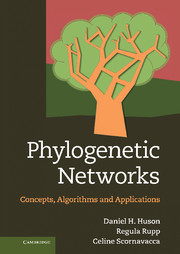6 - Clusters and rooted phylogenetic networks
from Part II - Theory
Published online by Cambridge University Press: 05 August 2011
Summary
The concept of a cluster plays a fundamental role in classification: For a set of taxa X we may want to group some of the elements together in the form of a cluster, for example, because they share an attribute that distinguishes them from other elements. In the context of phylogenetic analysis, clusters should be clades or monophyletic groups that reflect the evolutionary history of a set of taxa.
Any rooted phylogenetic tree represents a set of compatible clusters. In this chapter, we study rooted phylogenetic networks that can be used to represent sets of incompatible clusters, as well. In phylogenetic analysis, incompatible sets of clusters may occur due to reticulate evolutionary events, such as hybridization or horizontal gene transfer, or they might reflect uncertainties due to insufficient data or inadequate analysis methods.
Ideally, a rooted phylogenetic network should explicitly explain the evolutionary history of a set of taxa in terms of evolutionary events such as mutations, speciations and reticulate events. Methods are beginning to emerge to address this challenge, but, as we shall see, practical methods for computing such networks have not yet been established.
In this chapter, we attempt to give a unified approach to rooted phylogenetic networks, bringing together a number of different topics and issues that have so far been treated separately in the literature. This chapter contains some material that is new and has not appeared in print before.
- Type
- Chapter
- Information
- Phylogenetic NetworksConcepts, Algorithms and Applications, pp. 127 - 184Publisher: Cambridge University PressPrint publication year: 2010



